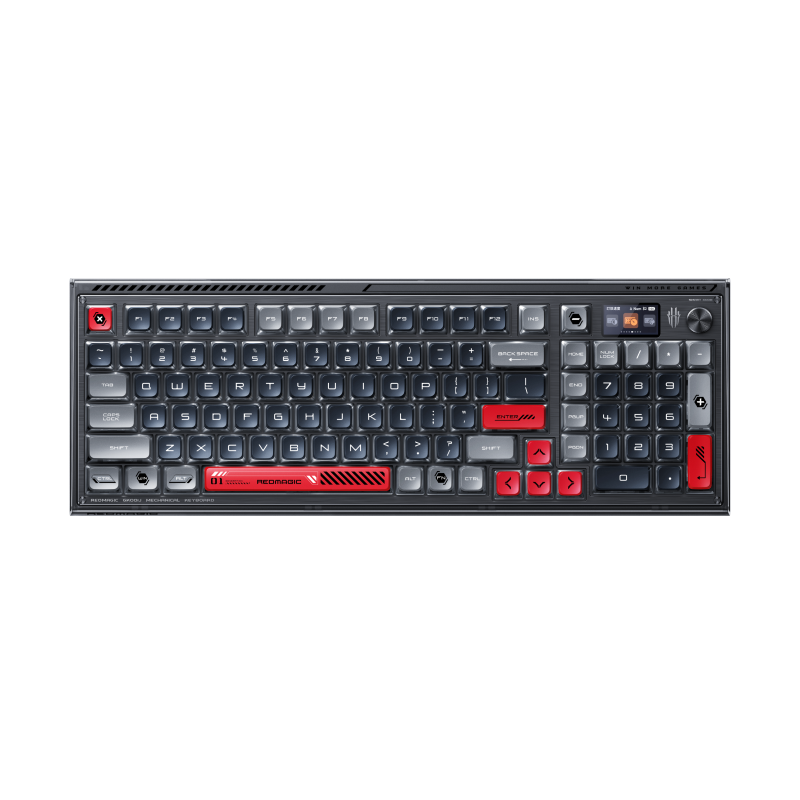
Innovation has always been the cornerstone of success. From early debates in philosophy and trying to understand the stars to modern medical breakthroughs and advanced machines, the act of improving on existing ideas has allowed us to reach pinnacles of knowledge previously unfathomable. Technology is often the best example of this phenomenon, having evolved through the ages to meet growing demands, overcome obstacles, and pioneer new methods.
For gaming, innovation came in many different ways. From consoles and games to enhanced processing power and immersive graphics, the gaming industry is always on the cusp of a new era. Today, we’ll be focusing primarily on the history and innovation of cooling in the mobile gaming community. We’ll be looking at some of the earlier methods of cooling, the challenges faced, and how they’ve evolved with time.
This will hopefully shed some light on the leaps of progress being made in our REDMAGIC labs to create gaming devices that last longer, perform better, and constantly strive to be more. First, let’s get a better idea of what cooling is and how it became a mainstream requirement in gaming.
What Is a Cooling System?
Everyone has experienced a hot phone at some point in life, whether you got carried away watching TikToks or decided to beat that next level, no matter how long it took. Every device you use for a long period will begin to generate heat. However, gaming smartphones tend to take that task a bit more seriously. With elevated performance and demanding processing, a gaming phone typically generates a lot more heat than a regular phone a lot faster.
This is where cooling systems come into play. They’ve been used for decades now to keep computers, data centers, and other electronics cool. More specifically, a cooling system for a gaming smartphone works at redirecting or removing heat from critical components through the use of thermo-conductive materials, coolants, or fans and expelling it into the surrounding environment.
Why Is Cooling Important in Gaming Smartphones?
Gaming generates massive amounts of heat, and without reducing or removing that heat effectively, you can damage your device and drastically hinder performance. According to Fullsync, when heat isn’t managed effectively, it can lead to thermal throttling, reduced performance, or even permanent damage to the hardware. For gaming smartphones, thermal build-up can lead to lag during your game, burning fingertips as you play, and general battery depletion and damage.
Keeping your device cool while you game ensures that your performance stays optimal, your framerates are stable, and your graphics never falter. Many gaming smartphones simply make use of external coolers, which can be attached to the outside of your phone. These are effective; however, gaming smartphones need to integrate advanced cooling systems as well to keep up with the growing demands of today’s gaming scene.
Smartphones can generate excessive amounts of heat due to the popularity of high-performance apps, the use of AAA games, video editing, and 5G connectivity. Uncontrolled overheating can result in reduced performance, damaged hardware, and a shorter battery life.
With a better grip on why cooling is so necessary for gaming smartphones, let’s take a stroll down memory lane and look at some of the key inventions that led to some of the modern cooling systems we see today.
A Different Ice Age
To understand the beginnings of smartphone cooling, you need to understand the humble roots of PC cooling. That’s right, kids, we have to travel back before the average gaming smartphone was even a thing. Now, the concept of a water-cooling system for a typical computer setup took form around the mid-1960s.
IBM’s Liquid Cooling System
In 1964, global tech company IBM revealed its pioneering IBM System/360. This was notably one of the biggest steps in computer technology history and one of the earliest uses of liquid cooling for computer equipment. The System/360 introduced a system of mainframes in which computers were no longer viewed as collections of individual components, but rather as platforms.
People working with System/360 components in 1964. Sourced from IBM
The computer system was designed to handle high-speed data processing in scientific applications, such as space exploration, theoretical astronomy, subatomic physics, and global weather forecasting. Naturally, this meant that the system required a significant amount of power, and to prevent the mainframe computer from overheating, IBM developed a specialized built-in water-cooling system.
Data Center Cooling
By the 1980s, liquid cooling was popular for supercomputers and mainframes and could be seen as the early precursors to today’s data centers in terms of computer density, power use, and heat generation. The sudden interest in cooling through more than air ventilation spurred a new venture into liquid and immersion cooling methods across industries.
PC Cooling
The 2000s were an expanding point for the PC market, according to Geeker Hertz. Companies began manufacturing PC mod components to increase the performance of home computers. Through this drastic movement, water cooling kits became commonplace and proved to be far more durable and efficient than DIY water-cooling setups.
In 2006, at a Power and Cooling Summit in London, IBM researchers presented their latest research on improving the cooling of computer chips called “direct-jet impingement”. This involved applying a fluid coolant directly onto the back of a chip, then removing it again in a perfectly closed system using an array of up to 50,000 tiny nozzles and a complicated tree-like branched return architecture.
Modern Cooling Systems
Since the earlier days of cooling designs, the devices that need to be cooled have evolved and advanced as well. Today, we have multiple cooling systems available that make use of enhanced materials and cooling components. Many cooling systems use smart integration with AI and other technologies as well to improve efficiency and accuracy.
Now that we know a brief history of cooling mechanics, we can get down to the specifics of cooling systems and see the different types of cooling components available today for electronics.
Types of Cooling Systems
Generally, you can narrow cooling systems down into air or liquid; however, you can further categorize them into two groups: active and passive cooling. These set the baseline for how technology has been cooled throughout the years.
Active Cooling
Methods of active cooling often involve moving parts, like external fans, compressors, or cooling liquids, to actively remove heat – a good example would be an air conditioner. These systems get rid of heat generated by internal components by enhancing convective heat transfer, which is the removal of heat through the flow of a fluid. Liquid cooling uses a coolant to absorb and transport heat to a radiator, where it is then dissipated. For a PC, a coolant, which is usually a mixture of water and antifreeze, circulates through a loop that includes a water block, pump, radiator, and tubing.
Sourced from How It Works
The water block is attached to the CPU or GPU and absorbs the heat. Then, the heated coolant is pumped to the radiator and cooled by fans before being recirculated. Liquid cooling can manage higher thermal loads, making it ideal for overclocked systems or high-performance gaming PCs, or advanced gaming smartphones.
Passive Cooling
Like the name suggests, passive cooling is a lot less engaged. In these setups, heat is often removed solely through the thermal conductivity difference between materials. This means that heat dissipation was made possible through the properties of the materials used in the device. This usually included plastic, aluminum, and other materials.
A popular example is the use of heat sinks. These are pieces of metal that conduct heat and are placed near a fan, allowing the air to rush over the heatsink and carry heat away. In both PCs and gaming smartphones, the heatsink is often attached directly to the CPU or GPU using thermal paste for efficient heat transfer.
Passive cooling was a favorite for most phone and tablet manufacturers who had to optimize space inside their devices and would try to avoid adding fans or other active cooling components. However, with the advent of the gaming smartphone, developers suddenly had to meet a growing demand for performance and cooling capabilities.
Now, high-end gaming smartphones incorporate graphene sheets and vapor chambers into designs to passively dissipate heat. Vapor chambers use a sealed environment where liquid can absorb heat, vaporize it, and then condense that heat back into a liquid. Heat pipes are another passive cooling component that shook the industry. These thin copper tubes were used to transfer heat away from the processor to the cooler parts.
According to How to Geek, choosing between active and passive cooling depends on your priorities. Active cooling is often associated with better performance, and passive cooling is linked more to portability, silence, and battery longevity.
Electronics supplier, Arrow, mentioned that active cooling technologies, while generally offering more rapid and efficient temperature reduction, are less popular due to their size, power requirements, noise, and cost. They state that even the smallest fans and blowers are generally too large and power hungry to deploy inside smartphones and tablets.
However, the company makes at least one exception to this norm, mentioning the REDMAGIC 3, which incorporates both a liquid-cooling copper heat pipe and an internal 14,000 RPM cooling fan. Now, let’s look at the concept of liquid metal cooling and how REDMAGIC pioneered a new way of using it to cool gaming smartphones.
Liquid Metal Cooling
Liquid metal refers to substances that exhibit both the features of metallic compounds and liquid fluids. Therefore, they not only have the ductility and conductivity of metal compounds but also have the fluidity and compliance of liquid fluids. For cooling purposes, liquid metal, often made of gallium and other metals, ensures rapid heat dissipation from the CPU or GPU to the heatsink.
Traditionally, liquid metal cooling technology has been used mainly in gaming laptops to keep temperatures low during intense gameplay. While liquid metal offers superior thermal management, it does have its drawbacks as well. Its flow is difficult to control, and it can corrode materials like copper and iron. In laptops, liquid metal is typically applied between the CPU and fan, with minimal risk of leakage since laptops are usually stationary.
However, at REDMAGIC, we aim to innovate and find a way around every problem. This is why we used an upgraded indium-based alloy with a melting point of 150°C. The primary component of this liquid metal is potassium, a low-temperature alloy. Together, they form a solid piece of metal with exceptional thermal conductivity.
This allowed us to get past the issue of viscosity, creating a solid-state material suitable for use in a mobile phone. With thermal conductivity upgraded from 80 W/m·K to 200 W/m·K, resulting in a CPU temperature reduction of up to 5°C, our use of Liquid Metal 2.0 significantly improves overall thermal performance and gaming stability.
Additionally, by lowering the softening point from 60°C to 50°C, the liquid metal adheres more effectively to the chip surface, further enhancing heat dissipation efficiency. Unlike traditional liquid metals, the new version eliminates the risk of leakage and corrosion, offering a safer and more durable solution.
Challenges to Gaming Smartphone Cooling
For TMN, the real challenge of mobile phone cooling lies in “striking a balance between the rapid generation and effective dissipation of internal heat, amidst the increase in processor performance, reduction in device size, and growing user demands.” In essence, gaming smartphones need to be able to get rid of heat as quickly as their high-powered processors can generate it. The publication continued to list challenges to mobile phone cooling as:
-
Increased Performance Demands: Users are now demanding more processing power to handle larger games, graphics, and tasks. From streamers and content creators to regular gamers, everyone needs a gaming smartphone that can keep up. However, this means more heat to deal with as well.
-
Design Constraints: The modern shift in smartphones prioritizes compact and portable dimensions. This means that gaming smartphones had to be smaller and would now have limited space to add typical cooling components.
-
Popularity of Mobile Gaming: The sudden rise of streaming and expanded mobile gaming capabilities also pushed developers to create devices built for prolonged usage with heightened graphics, while needing thermal management to stabilize performance.
-
5G Technology: The spread of 5G technology meant faster data speeds and increased network complexity. This requires better heat dissipation to maintain performance.
-
The Need for Protected Longevity: As the demand grew, gaming smartphones quickly began competing in terms of battery size. A phone that lasts longer keeps you winning for longer. This meant a focus on cooling technologies to prevent overcharging, overheating, and other forms of battery damage.
Now that we know some of the challenges facing cooling in the mobile gaming industry, let’s try to end on a more positive note, looking into what the future holds.
Future Trends in Smartphone Cooling
The mobile phone cooling component market size is projected to reach USD 9.8 billion by 2033. This indicates a clear increase in cooling technology for future smartphone designs. According to a LinkedIn article studying the popularity of mobile phone cooling components, the market is witnessing rapid innovation in the use of advanced cooling materials, such as graphene-based thermal interfaces and phase change materials, driving improved heat dissipation efficiency for high-performance mobile devices.
When it comes to the future of cooling technology in the gaming smartphone industry, the role of AI and the Internet of Things cannot be overstated. These platforms will be the ideal segway to enable smart real-time thermal management, enhancing longevity and accuracy.
The article also noted that “strategic collaborations between tech giants and component innovators are fostering breakthroughs in miniaturized, energy-efficient cooling modules,” which align with global sustainability goals. This means that smarter mobile cooling solutions would ultimately be better for the environment as well, drastically reducing e-waste by extending the lifespans of devices and internal components.
In the long run, cooling technology for gaming smartphones has and will continue to improve with every new innovation in the field. These future trends offer a bright light at the end of the tunnel for both gamers and developers in the industry. At REDMAGIC, we can assure our fans that we will continue to be at the frontlines of innovation to give you the best devices around. Speaking of which, let’s take a brief look at some of the mobile cooling innovations happening at REDMAGIC.
REDMAGIC: Cooling Pioneers
At REDMAGIC, we believe that every problem is an opportunity to be better. This is why we looked at the issue of mobile phone cooling and hit the drawing board from the beginning. In 2019, our REDMAGIC 3 gaming smartphone hit the scene and became the first smartphone with a built-in fan, setting a new standard for gaming smartphone heat management.
But we don’t live in the past too much and don’t need to look too far back to see the cooling innovation we’ve pioneered right now as well. Naturally, the use of liquid metal was a major stepping stone for REDMAGIC’s cooling capabilities. In our REDMAGIC 10 Pro’s multi-layered ICE-X system, we used a groundbreaking alloy-based solid-state liquid metal to boost thermal conductivity.
The REDMAGIC ICE-X system alone is enough to take your breath -and the heat – away. This layered system, found in most of our devices, from smartphones to tablets, often boasts a massive vapor chamber, high-speed turbo fans, layers of graphene, copper insulation, and more – all precisely layered and positioned to improve heat dissipation.
Positioning has played a pivotal role in cooling for REDMAGIC, especially in our latest 10S Pro. Here, we were able to manipulate the viscosity of Liquid Metal 2.0 into a solid-state piece. This allowed us to reposition the material directly over the chip, providing 30% more coverage and reducing the CPU temperature by up to 5°C when compared to the 10 Pro.
Another great cooling innovation from our end was in the design of our REDMAGIC Golden Saga 10 Pro, where the phone was draped in a frame of carbon fiber for its excellent thermal conductivity. Typically, carbon fiber would be used in high-end luxury sports cars due to being lightweight and resistant, but it is often also placed over the hood or engine itself, so the intense heat generated is transferred to the composite material, which then dissipates the heat to a cooler area.
Chasing the Chill
Innovation is essential, and it helps us breathe new life into old ideas. From supercomputers and water-cooling systems in the 60s to modern vapor chambers and liquid metal, the cooling evolution in electronics has been quite the adventure – reinforced by the need to make users’ lives easier while improving gameplay.
This dedication to innovation is what pushes us at REDMAGIC to always provide the best technology, features, and products we can create. From superior cooling to enhanced performance, we hope to cement the REDMAGIC name as a pioneer in the industry that might be spoken about years from now as well.





















